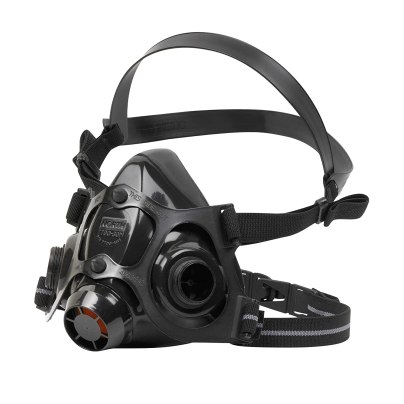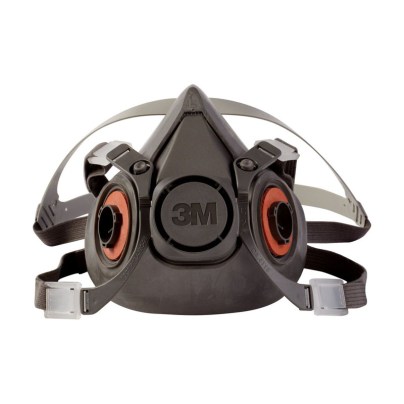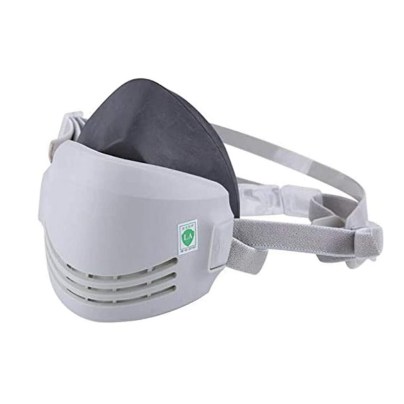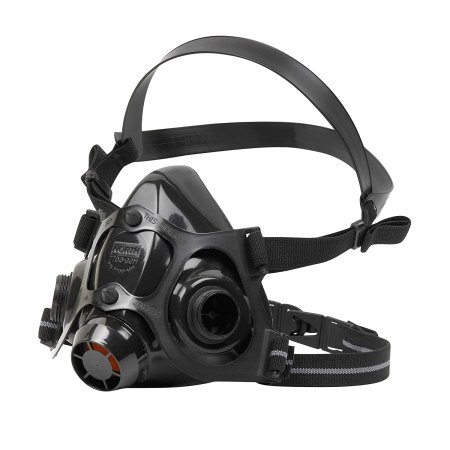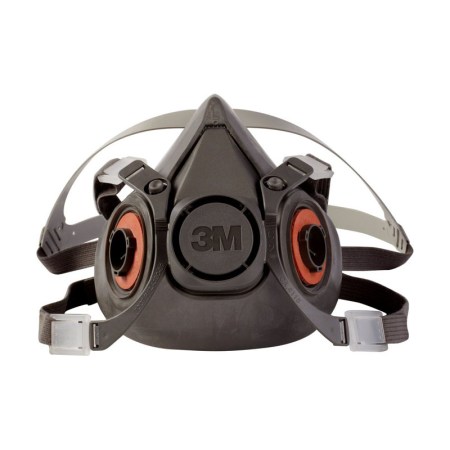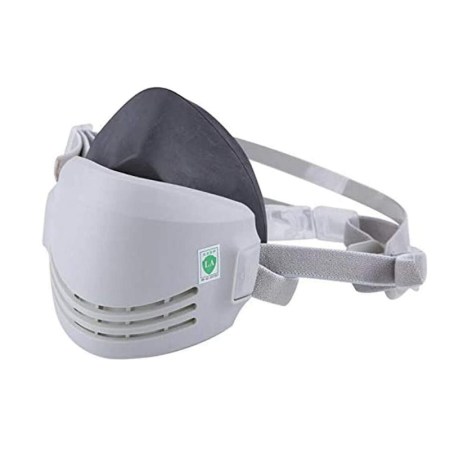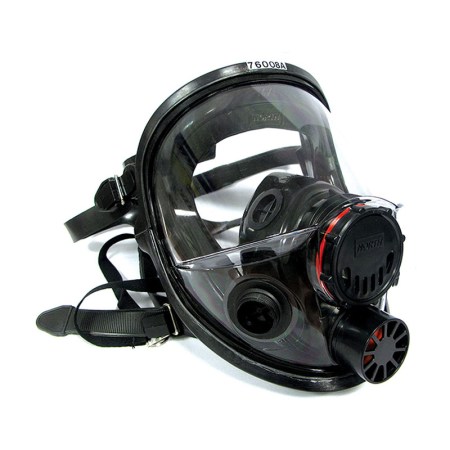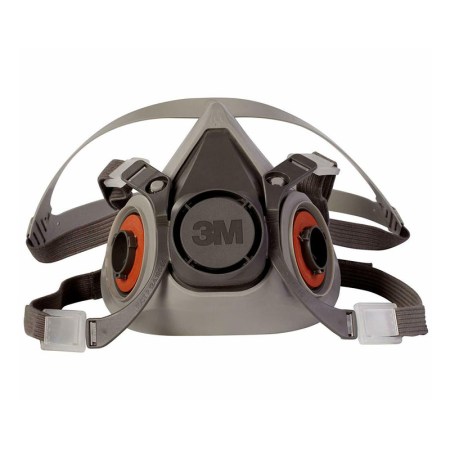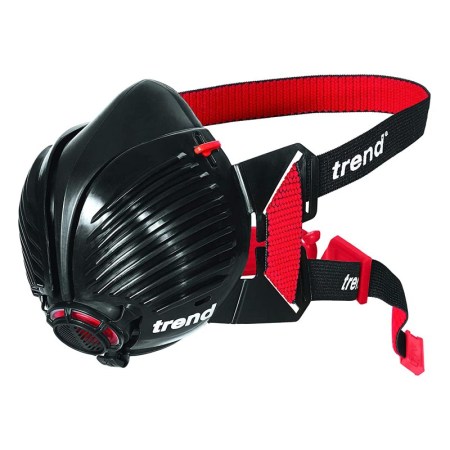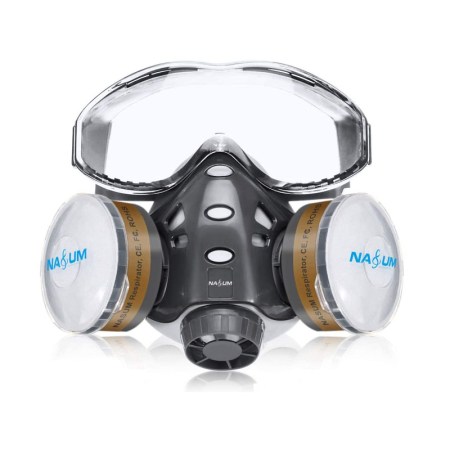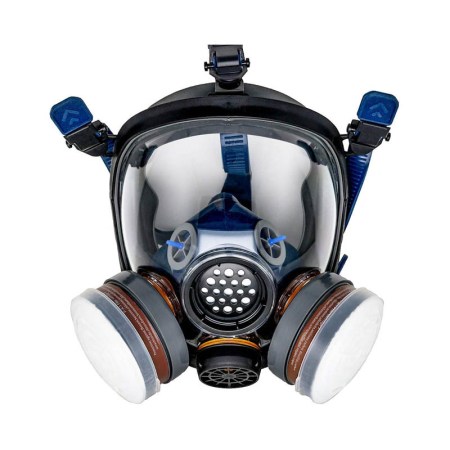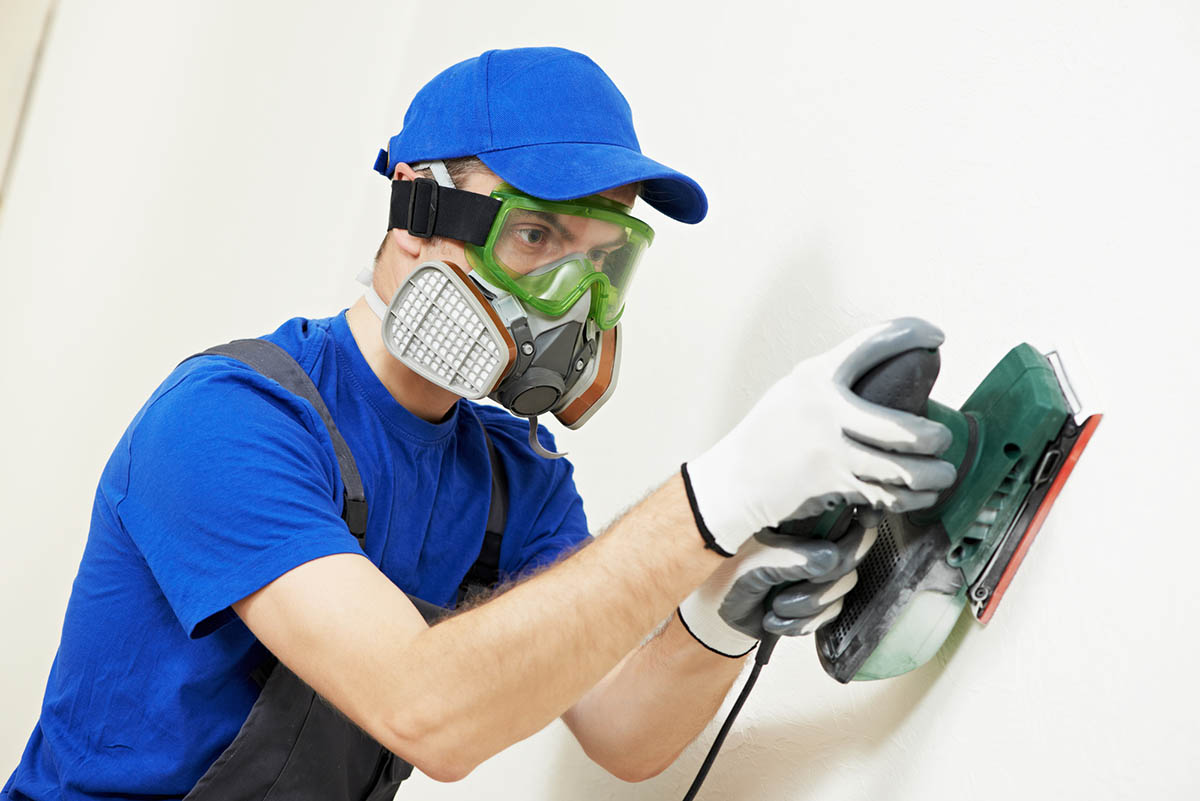
We may earn revenue from the products available on this page and participate in affiliate programs. Learn More ›
Some DIY activities can send irritating particles or vapors into the air. Having to work around airborne particulates is annoying, but sometimes it’s even unsafe. According to the New York State Department of Health, some particularly noxious vapors can make their way into your bloodstream via your lungs and poison you. Activities like sanding, welding, painting, or even repairs can decrease your workshop’s air quality, possibly putting your health at risk.
Instead of allowing harmful airborne irritants to make their way into your mouth, nose, throat, or lungs, you should use a respirator and other protective gear. Respirators fit over your nose and mouth to form an air filter to reduce the number of particles and vapors you inhale. The best respirator for your project will vary, but this guide will help you choose one for your workshop needs.
- BEST OVERALL: Honeywell North 7700 Series Half Mask Respirator
- RUNNER UP: 3M Half Face Piece, Reusable Respirator
- BEST BANG FOR THE BUCK: RANKSING Strong-AX Half Reusable Respirator
- UPGRADE PICK: North 760008A Silicone Full Facepiece Respirator
- BEST FOR SPRAY PAINTING: 3M Thermoplastic Elastomer Half Mask 6000 Series
- BEST FOR WOODWORKING: Trend Stealth Air APF10 Half Mask Respirator
- BEST FOR MOLD: NASUM Reusable Half Face Cover, 8200
- BEST FOR CHEMICALS: Parcil Distribution PT-100 Full Face Respirator
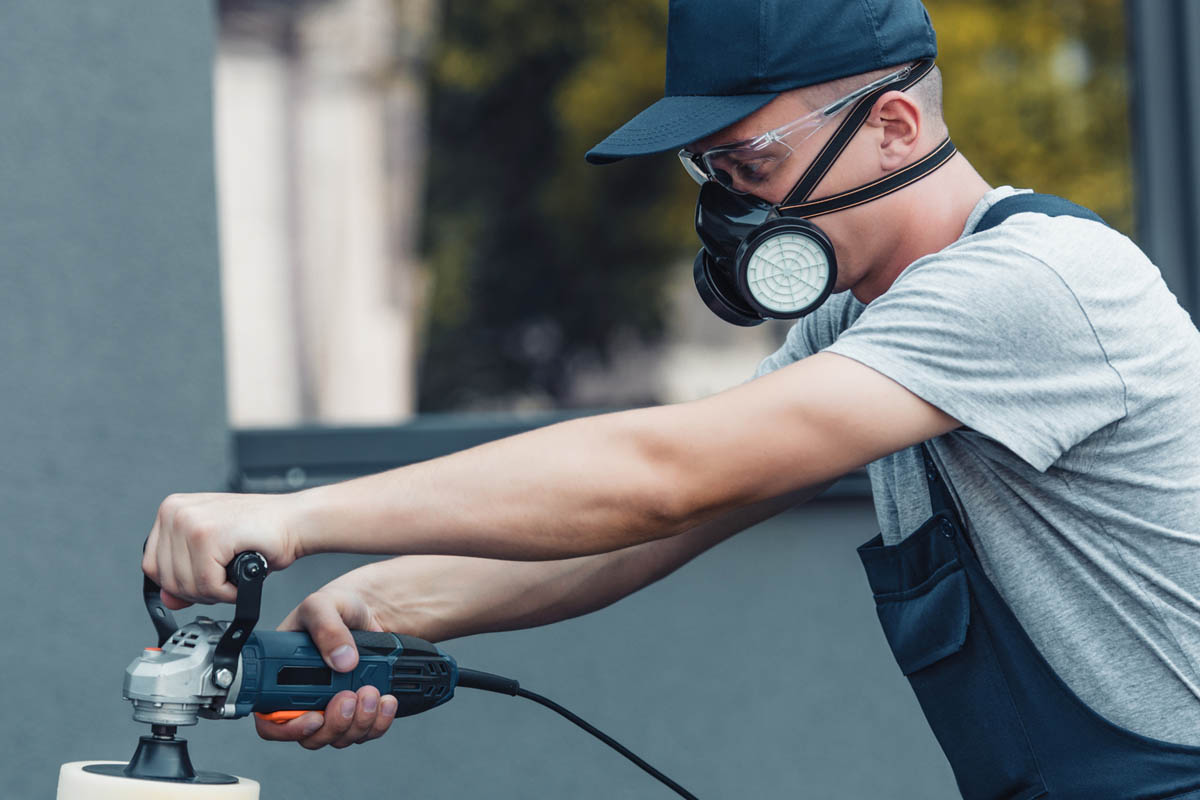
Types of Respirator Masks
Respirator masks, while all serving the same purpose, look, and perform their duties a little differently. Depending on the style of the respirator and the type of project, some of these types of masks will work better than others at keeping your airways, and even your eyes, irritant-free and protected.
Air-Purifying vs Air-Supplying
There are two types of respirators; air-purifying and air-supplying (or atmosphere-supplying), and they’re very different in design and function. Here are the OSHA-approved definitions:
- Air-purifying respirators have filters, cartridges, or canisters that remove contaminants from the air by passing the ambient air through the air-purifying element before it reaches the user.
- Atmosphere-supplying respirators supply clean air directly to the user from a source other than the air surrounding the user.
In other words, air-supplying respirators use motors to pump clean air into a hood or mask to the breather. They may have filters, but they get their supply of clean air from a source outside the work area. These respirators are most common in disaster situations or in areas with extremely volatile contaminants.
Air-purifying respirators remove contaminants as the user breathes in. The breath pulls the particulates toward the mask, which traps them in the filters. Some of these masks have replaceable filters so that the user can throw out a used filter. Or, in the case of paper masks, you throw it out altogether. This style of air filtration is by far the most popular with DIYers.
Disposable Paper Mask
Disposable paper masks are popular with DIYers as they’re inexpensive and comfortable to wear. They do a good job of removing sanding dust from woodworking projects and joint compound from drywall jobs.
These masks are very light, and they use elastic straps around the user’s head to stay in place. They feature a thin metal bar on the nose that bends to provide a good fit over the nose and mouth.
When the user breathes in, air pulls through the microscopic holes in the mask. Particles larger than those holes land on the mask and get stuck. When these masks become overly dirty and clogged with dust and dirt, the user can throw it out and get a new one.
Half-Mask
Half-mask respirators cover the lower half of the user’s face, providing a seal around the nose and mouth. They have adjustable straps that wrap around the user’s head and tighten, blocking the pathways around the seal.
These masks have ports in the front of the mask that the user breathes through. They typically use replaceable cartridges to filter out contaminants. The cartridges twist onto the mask and snap into place. They work similarly to a paper mask, only allowing clean air into the nose and mouth.
Some of the cartridges are reusable, though most users throw them out and replace them with fresh sets once they become visibly dirty.
These masks are great for any project in the workshop. You can outfit them with a variety of different cartridges, depending on the work you’re doing.
Full-Mask
Full-mask respirators work very similarly to half-mask respirators. They use disposable and replaceable cartridges (the same ones, in fact), and they block the airways from contaminates by creating a seal.
The difference between the two is that a full-mask respirator covers the entire face, creating a shield over the eyes. It still has a seal around the mouth and face, but this extra layer of protection creates an additional barrier that particles are less likely to sneak by.
Full-mask filters are very effective when eye protection is necessary, as in the case of installing fiberglass insulation, using a paint sprayer in a tight workshop, or even sanding materials if you’re particularly allergic to certain hard or nut woods.
Gas Mask
Gas masks are easy to recognize. They are thick rubber masks that cover the user’s entire head or face, with two eye-holes covered with thick plastic shields that look like bug eyes. Aside from being staples in horror films, they can be extremely effective at protecting the wearer from harmful chemicals, such as those sometimes used in military action.
Gas masks use filter cartridges to block out harmful gases and chemicals. The user has to fit the mask with the correct cartridge for the chemical at hand. They’re very hot and only mildly effective in a DIY setting. You’re unlikely to see anyone willingly choose to wear one during a project.
What to Consider When Buying the Best Respirator
There are a lot of considerations to think about when choosing the best respirator for your workshop and home projects. You should consider how much filtration you need, the types of filters, and how well the respirator will adjust to your face. Read on to learn about these considerations and others so you can choose the best respirator.
Rating
Respirators come in different ratings according to what they’re effective at filtering. These ratings come in the form of a letter/number combination that designates their uses.
Letter designations include N, R, and P:
- Masks designated with an N are not oil-resistant.
- Masks with R designations are resistant to oil.
- Masks with P designations are oilproof.
The number describes the mask’s effectiveness at removing particles that are sized .3 microns in diameter and larger. Masks with a value of 95 are 95 percent effective, values of 99 are 99 percent effective, and values of 100 are 99.97 percent effective.
So a P100 mask, which is the highest rating, is oil-proof and 99.97 percent effective at removing particles that are .3 microns and larger. An N95 mask is not oil-resistant but is 95 percent effective at removing those particles.
Filter & Cartridge Type
Filter cartridges come in a wide range of colors, coded specifically for the particle or contaminant that it protects against. For instance, a cartridge with a white label is effective for filtering acid gases, while blue indicates that it will filter carbon monoxide, and green is effective against ammonia.
For DIYers, the most commonly used filters and cartridges will be purple, green, and teal. Purple indicates a P100 rating, effective against any particulates. Orange indicates a rating of P95, P99, R95, R99, and R100 against any particulates. Teal represents an N95, N99, or N100 rating, also against any particulates.
These filters snap and twist onto the ports on half-mask and full-mask respirators. They can also come in cartridges that twist onto air-supplying respirators.
Fit & Adjustability
You may have a P100 respirator, but it won’t do you any good if unfiltered air can make its way into your airway first. If air can sneak behind the mask seal, it may be potentially contaminated and harmful to your health.
Poor seals are usually the result of poor fitment or adjustability. To ensure that you’re safe, you should use a mask that provides the best possible fit. The best respirators have two or three adjustable straps that you can use to position the mask correctly (over your nose and mouth without any gaps). These straps are also how you’ll adjust the seal to be snug but not uncomfortable.
Material
While cartridges do most of the work purifying your air, your mask’s construction material can be equally important. If the material is too stiff or brittle, it won’t provide the type of seal you need to stay safe in many conditions.
Respirators made of rubber and silicone create a secure seal. Both of these materials can flex when the user turns their head or looks up, while still providing an airtight seal.
They’re both durable as well, with rubber being the most resilient. Durability is important because respirators are tools that are likely to see their fair share of abuse. If your respirator breaks or rips even a little bit, it’s no longer any good.
Maintenance
It’s essential to maintain your respirator to ensure it lasts as long as possible. While cartridges are throw-aways, the respirator itself is not.
A day of respiration can harbor a lot of bacteria, and your respirator needs cleaning. The ideal way to clean your mask is to disassemble all of its parts and hand wash them in warm water with disinfectant soap.
While cleaning your mask, it’s a good time to check it for cracks or tears. Check the straps, the seal, and the face shield (if so equipped) for any signs of wear. If you see anything that indicates that your respirator is not in top working order, replace it with another. It’s not worth risking your health for the price of a respirator.
Our Top Picks
Choosing the best respirator may seem daunting, since, depending on your project, there could be a lot riding on your decision. It’s best to do your research when shopping for the best respirator. However, the list of respirators provided below contains some of the best options available on the market right now. Choosing one of these products will ensure that you get a good seal and top-notch protection.
Best Overall
Honeywell North 7700 Series Half Mask Respirator
If you’re looking for a top-notch quality half-mask that’s flexible and comfortable, the 7700 Series is a great choice. This is a 100 percent medical-grade silicone face mask, meaning it’s durable and flexible enough for just about any job you’re tackling. It uses two twist-on cartridges (available here or here) to filter out harmful particulates. It features a two-way adjustable head strap for alignment and an elastic neck strap to provide an excellent fit and seal. Honeywell designed the seal with varying thicknesses at specific points to create the best possible seal over the nose, cheeks, and around the mouth.
Runner Up
3M Half Face Piece, Reusable Respirator
For a workshop dweller that prefers a streamlined half-mask, the Half Face 6300 Respirator from 3M is an excellent choice. This mask uses a two-way adjustable head strap to position the mask at the perfect height relative to the user’s mouth and nose, and a neck strap to help promote a proper seal. This harness doesn’t restrict the range of movement or compromise a good seal. The 6300 is lightweight, compact, and comes in a few sizes. Users can fit them with a variety of cartridges (available here), allowing them to customize their protection level against specific particles.
Best Bang for the Buck
RANKSING Strong-AX Half Reusable Respirator
Not everyone needs a top-notch respirator. If you’re looking for a lightweight option that will filter out dust and small particles, the RANKSING Strong-AX Half Respirator is a fine choice. It’s made with hypoallergenic rubber that’s easy to clean but soft enough to create an excellent seal without being uncomfortable. It’s also lightweight, and the two-piece harness holds the mask in place while still allowing you to turn your head freely. It uses replaceable charcoal filters (available here) that the user can quickly remove and replace. These filters are far less expensive than standard cartridge filters, saving you some money in the long run.
Upgrade Pick
North 760008A Silicone Full Facepiece Respirator
No one would blame you for taking your respiratory needs seriously. If you’re looking to protect yourself as much as possible, the North 760008A Silicone Full Facepiece Respirator will do the trick. This full-face respirator creates a seal around your mouth and nose while also creating an additional seal around your entire face. This promotes a perfect seal, keeping harmful particulates from sneaking through any leaks. The face shield contains a polycarbonate lens, which protects your eyes better than any safety glasses. It also features an adjustable harness to help create a comfortable fit with maximum protection. You can outfit it with a wide range of cartridges (available here or here). It can also feature a speech diaphragm, which makes it easy to communicate with people around you without compromising your protection.
Best for Spray Painting
3M Thermoplastic Elastomer Half Mask 6000 Series
Paint projects always seem to take longer than you expect. Whether painting a room or using volatile oil-based paints on a workshop project, you need a mask that you can wear for a while without becoming uncomfortable. The 3M 6000 Thermoplastic Elastomer Half-Mask is the mask for the job. This lightweight, comfortable half-mask features soft rubber to create a tight fit. The four-point harness uses elastic straps and does a good job of securing the mask to the user’s face without creating gaps when they turn their head or look up and down. The cartridge locations are more streamlined than other models, allowing for a better line of sight—essential during painting projects. It works with cartridges and filters (available here and here), so customizing your level of protection is quick and easy.
Best for Woodworking
Trend Stealth Air APF10 Half Mask Respirator
You don’t have to be allergic to nut-bearing woods for dust to irritate you during a woodworking project. If you’re particularly sensitive, however, it can be downright miserable. The Trend Stealth APF10 Half Mask Respirator is an excellent lightweight, streamlined mask that woodworkers will love. This mask uses replaceable filters (available here) that allow you to customize your filtration needs. It also features two flexible elastic head straps to maintain a good seal. One standout feature is the bottom-mounted exhalation valve. This valve means you won’t have to worry about fogging up your safety glasses while you’re working—a must-have while working with power tools or sharp hand tools. The styling and bright red accents make this mask easy to find in a dark workshop.
Best for Mold
NASUM Reusable Half Face Cover, 8200
Mold remediation is serious business, and it requires the right personal protective equipment. The NASUM 8200 Half Face Cover is the perfect tool for staying safe during a nasty job. This respirator includes a set of built-in polycarbonate safety goggles that help to protect your eyes and skin from harmful spores. The soft silicone mask helps you achieve a tight, safe seal, keeping spores and dusts from making their way into your lungs. The NASUM 8200 uses replaceable filters (available here, here, and here), so once a cartridge becomes saturated, you can swap it out quickly with a clean one and get back to work.
Best for Chemicals
Parcil Distribution PT-100 Full Face Respirator
Harsh chemicals can wreak havoc on your lungs. To keep those nasty fumes at bay, you need a high-quality full-mask respirator. The Parcil Distribution PT-100 is a great choice. It features a full-face impact-resistant lens to help you see as well as possible. It also has ratcheting pull-straps that quickly and easily adjust to your head. It has a soft silicone seal around your nose and mouth to create the best possible barrier against fumes and gases. It also comes with two activated charcoal filters, so it’s effective against several chemicals right out of the box. You can purchase replacement filters for the PT-100 (available here).
The Advantages of Owning the Best Respirator Mask
Tackling a dusty project without a respirator can lead to some nasty results. Your nasal passages and throat can become irritated or clogged, making you feel like you’re experiencing allergies (which you essentially are). If you’ve got your own respirator, you can block those irritants from making their way into your airways.
Noxious gases can make their way into your bloodstream through your lungs. If you’re working with harsh chemicals, you can throw your mask on and filter them out of your breathing air. You can swap the cartridges to match the chemicals you’re using, ensuring that your workshop is a safe place.
Some cartridges have room for stacking with additional filters, creating a tremendously effective filtration system. By using a “pre-filter,” which is essentially a second filter, you can remove more particles than using one standard filter alone.
- Respirators can keep dust and particles from creating allergic reactions.
- Respirators prevent harmful chemicals from entering your lungs and bloodstream.
- You can stack filters inside of the cartridges.
FAQs About Respirator Masks
Respirators are a popular topic, but there are still some gray areas concerning them. If you’re not exactly sure about your new respirator, it’s probably for a good reason: a lot goes on inside those filters and masks. These are the most frequently asked questions and answers concerning the best respirators.
Q. How do I know if my respirator fits?
You should check positive and negative pressures every time you put your respirator on. For positive pressure, block the exhalation valve with your hand and exhale. Air should not be able to escape. To check negative pressure, block the filters or ports with your hands and inhale. Again, air should not be able to get in through the seals.
Q. How long is a respirator likely to last?
A filter can last five years if unopened and six months if opened. If you use your filter, change it daily. In regard to the respirator itself, the lifespan varies depending on maintenance. If there are no tears in the straps or seals and it passes the fit test every time you put it on, the respirator is fine.
